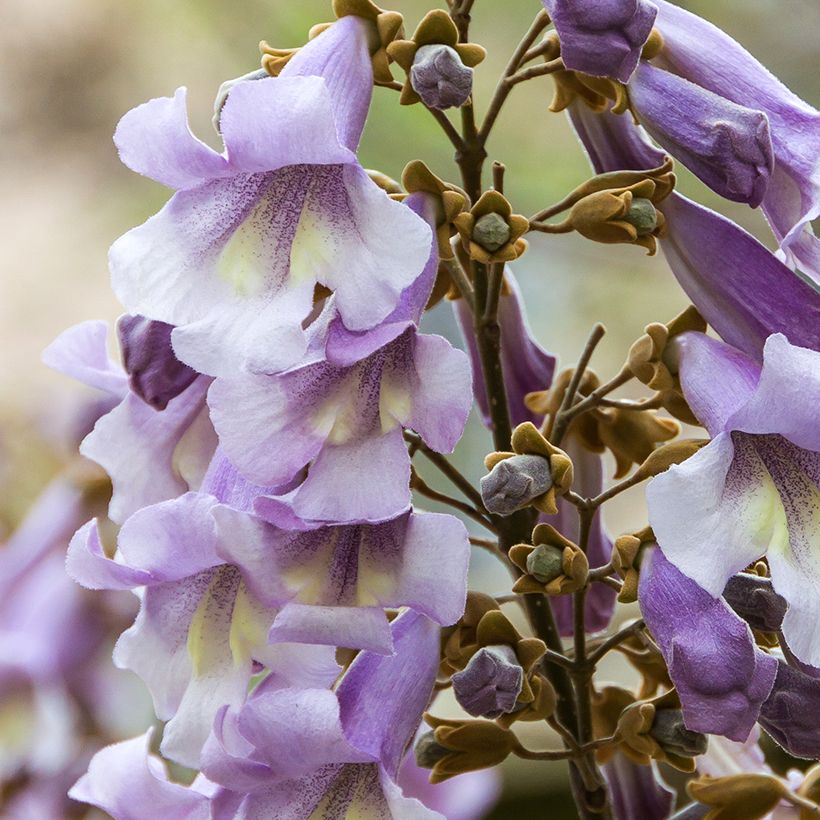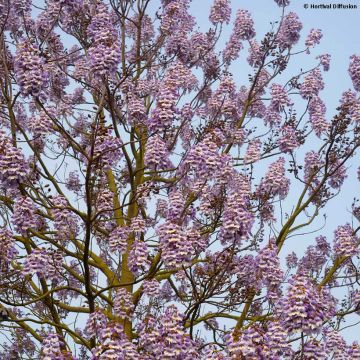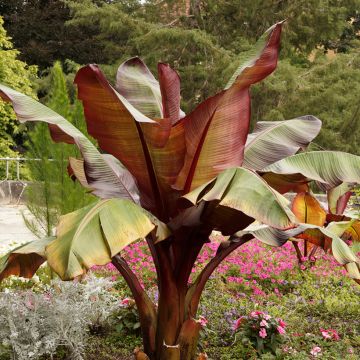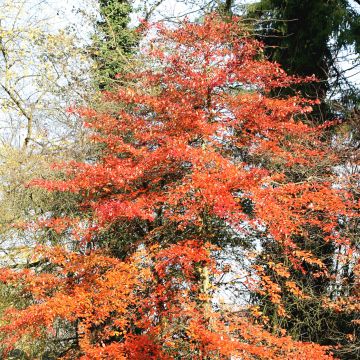

Paulownia tomentosa Hulsdonk - Arbre impérial


Paulownia tomentosa Hulsdonk - Arbre impérial


Paulownia tomentosa Hulsdonk - Arbre impérial


Paulownia tomentosa Hulsdonk - Arbre impérial


Paulownia tomentosa Hulsdonk - Arbre impérial


Paulownia tomentosa Hulsdonk - Arbre impérial
Paulownia tomentosa Hulsdonk - Foxglove Tree
Paulownia tomentosa Hulsdonk
Foxglove Tree, Princess Tree, Imperial Tree
Planted in May in medium condition, immediate regrowth, 7 cm in June and 1.40 m in September!
Chrystelle, 26/09/2025
Special offer!
Receive a €20 voucher for any order over €90 (excluding delivery costs, credit notes, and plastic-free options)!
1- Add your favorite plants to your cart.
2- Once you have reached €90, confirm your order (you can even choose the delivery date!).
3- As soon as your order is shipped, you will receive an email containing your voucher code, valid for 3 months (90 days).
Your voucher is unique and can only be used once, for any order with a minimum value of €20, excluding delivery costs.
Can be combined with other current offers, non-divisible and non-refundable.
Why not try an alternative variety in stock?
View all →This plant carries a 24 months recovery warranty
More information
We guarantee the quality of our plants for a full growing cycle, and will replace at our expense any plant that fails to recover under normal climatic and planting conditions.
Would this plant suit my garden?
Set up your Plantfit profile →
Description
The Paulownia tomentosa ‘Hulsdonk’ combines all the qualities of the species in a more stocky and compact habit, and above all with a faster flowering on young plants. Very graphic, this medium-sized tree, with a spreading habit almost as wide as it is tall, stands out primarily for its enormous leaves. Very decorative, they give the tree a lush appearance that catches everyone's attention. Its spring flowering is equally exceptional; large panicles of subtly scented violet flowers then cover the crown. Easy to grow, this Paulownia accepts most soils and is suitable for small gardens.
The Paulownia, formerly classified in the Scrophulariaceae family, now belongs to the botanical family Paulowniaceae, which is very exclusive with only 3 genera. Nicknamed the "imperial tree," Paulownia tomentosa, native to Asia and named after Anna Pavlovna, Queen of the Netherlands, is the best known. It is a fast-growing tree with a dense shade provided by its leaves. A tree with a very elegant and large habit, it is well suited to spacious gardens as it can reach a height of 12 m (39ft) and almost the same in width.
The cultivar Hulsdonk is named after a place near the small town of Zundert in the south of the Netherlands, where it was selected from Paulownia tomentosa seedlings. Its main advantage, which caught the attention of the nurseryman who discovered it, is that young plants flower more quickly than other plants of the species. After being cultivated, it has also proven to be more compact, which allows it to be used in small urban gardens.
This small to medium-sized tree reaches about 7 m (23ft) in height with a spreading crown reaching 5 m (16ft) in width. It has fast growth, which, combined with its early flowering, makes it a very attractive plant for achieving an interesting visual effect in the garden without waiting too long! From April, before the first leaves emerge, long panicles (up to 25 cm (10in)) of mauve-violet flowers appear, a rather rare color among trees (this type of color can be found in the Jacaranda, unfortunately not very hardy). The inflorescences consist of about twenty bell-shaped flowers approximately 3 to 4 cm (1 to 2in) long, tubular and opening trumpet-like at their ends. They exude a refined fragrance, difficult to describe but pleasant. The flowering evolves to produce fruits that are yellow-green capsules at first and then turn brown, which persist on the tree for a long time, often until spring.
The leaves appear after the flowers and coexist with them for some time. Of a spectacular size, measuring about thirty cm in length, they are approximately heart-shaped and create a dense shade on the ground. It is even possible to obtain even larger leaves by coppicing the tree, that is, cutting it back very close to the ground to obtain a stool (a clump with several trunks). The aspect of the vegetation is then even more impressive, at the expense of flowering, however. Remarkable for their graphic design, it should be noted that the deciduous leaves do not change color in autumn before falling.
The Paulownia Hulsdonk will thrive in a sunny position, sheltered from strong winds that can damage its branches and large leaves. It is accommodating regarding soil type, accepting neutral, as well as calcareous or acidic soils. Once well rooted, it is quite drought-resistant and is not afraid of urban pollution. Once established, its hardiness extends to about -20 °C (a young tree will tolerate temperatures around -15 °C).
A compact tree with multiple qualities, this Paulownia Hulsdonk will be perfect for creating a characterful scene in an urban garden. Planted alone on a lawn or in a flower bed, it will look proud with its extra-large leaves. It is undoubtedly one of the best flowering trees, with the added benefit of a particularly pleasant fragrance (Paulownia notes are actually used in perfumery). When possible, it is advisable to plant this Paulownia at the bottom of a slope to be able to admire its flowering from above against a backdrop of green grass, as the flowers have a colour close to that of the sky and will thus be better highlighted. The Golden Rain Tree (Koelreuteria paniculata) is another compact flowering tree, with its finely cut foliage contrasting with that of the Paulownia if you plant it nearby. Its later flowering, with bright yellow flowers, will take over from that of the Paulownia. You can also take advantage of the shade provided by Hulsdonk to plant shade-loving perennials, such as the beautiful Epimedium with its delicate flowers, or a perennial Geranium like Samobor with its small burgundy-red flowers.
Report an error about the product description
Paulownia tomentosa Hulsdonk - Foxglove Tree in pictures






Plant habit
Flowering
Foliage
Botanical data
Paulownia
tomentosa
Hulsdonk
Paulowniaceae
Foxglove Tree, Princess Tree, Imperial Tree
Cultivar or hybrid
Other Paulownia
View all →Planting and care
Plant your Paulownia tomentosa Hulsdonk in a sunny location, avoiding windy areas as its wood is brittle. It appreciates all types of soil as long as it is deep and you provide good drainage; waterlogged soils can lead to the attack of wood-rotting fungi (such as armillaria, a parasite that feeds on tree wood). After planting, water thoroughly to remove any air pockets. Water for a few weeks to promote root growth, especially if it doesn't rain. To enjoy its shade in summer, remove low branches when your tree is still young. Without this step, it will be difficult to walk underneath. Apart from that, simply remove diseased branches and dead wood, and you can also thin out the center of the tree by pruning branches that cross over each other. Be careful not to prune too large branches, as this will make your tree susceptible to fungi and weaken it irreversibly; it's best to stick to diameters less than 3 cm (1in). For coppicing, cut your tree to ground level every year in late winter, which will result in even larger leaves in spring (but no flowers!).
Planting period
Intended location
Care
-
, onOrder confirmed
Reply from on Promesse de fleurs
Similar products
Haven't found what you were looking for?
Hardiness is the lowest winter temperature a plant can endure without suffering serious damage or even dying. However, hardiness is affected by location (a sheltered area, such as a patio), protection (winter cover) and soil type (hardiness is improved by well-drained soil).

Photo Sharing Terms & Conditions
In order to encourage gardeners to interact and share their experiences, Promesse de fleurs offers various media enabling content to be uploaded onto its Site - in particular via the ‘Photo sharing’ module.
The User agrees to refrain from:
- Posting any content that is illegal, prejudicial, insulting, racist, inciteful to hatred, revisionist, contrary to public decency, that infringes on privacy or on the privacy rights of third parties, in particular the publicity rights of persons and goods, intellectual property rights, or the right to privacy.
- Submitting content on behalf of a third party;
- Impersonate the identity of a third party and/or publish any personal information about a third party;
In general, the User undertakes to refrain from any unethical behaviour.
All Content (in particular text, comments, files, images, photos, videos, creative works, etc.), which may be subject to property or intellectual property rights, image or other private rights, shall remain the property of the User, subject to the limited rights granted by the terms of the licence granted by Promesse de fleurs as stated below. Users are at liberty to publish or not to publish such Content on the Site, notably via the ‘Photo Sharing’ facility, and accept that this Content shall be made public and freely accessible, notably on the Internet.
Users further acknowledge, undertake to have ,and guarantee that they hold all necessary rights and permissions to publish such material on the Site, in particular with regard to the legislation in force pertaining to any privacy, property, intellectual property, image, or contractual rights, or rights of any other nature. By publishing such Content on the Site, Users acknowledge accepting full liability as publishers of the Content within the meaning of the law, and grant Promesse de fleurs, free of charge, an inclusive, worldwide licence for the said Content for the entire duration of its publication, including all reproduction, representation, up/downloading, displaying, performing, transmission, and storage rights.
Users also grant permission for their name to be linked to the Content and accept that this link may not always be made available.
By engaging in posting material, Users consent to their Content becoming automatically accessible on the Internet, in particular on other sites and/or blogs and/or web pages of the Promesse de fleurs site, including in particular social pages and the Promesse de fleurs catalogue.
Users may secure the removal of entrusted content free of charge by issuing a simple request via our contact form.
The flowering period indicated on our website applies to countries and regions located in USDA zone 8 (France, the United Kingdom, Ireland, the Netherlands, etc.)
It will vary according to where you live:
- In zones 9 to 10 (Italy, Spain, Greece, etc.), flowering will occur about 2 to 4 weeks earlier.
- In zones 6 to 7 (Germany, Poland, Slovenia, and lower mountainous regions), flowering will be delayed by 2 to 3 weeks.
- In zone 5 (Central Europe, Scandinavia), blooming will be delayed by 3 to 5 weeks.
In temperate climates, pruning of spring-flowering shrubs (forsythia, spireas, etc.) should be done just after flowering.
Pruning of summer-flowering shrubs (Indian Lilac, Perovskia, etc.) can be done in winter or spring.
In cold regions as well as with frost-sensitive plants, avoid pruning too early when severe frosts may still occur.
The planting period indicated on our website applies to countries and regions located in USDA zone 8 (France, United Kingdom, Ireland, Netherlands).
It will vary according to where you live:
- In Mediterranean zones (Marseille, Madrid, Milan, etc.), autumn and winter are the best planting periods.
- In continental zones (Strasbourg, Munich, Vienna, etc.), delay planting by 2 to 3 weeks in spring and bring it forward by 2 to 4 weeks in autumn.
- In mountainous regions (the Alps, Pyrenees, Carpathians, etc.), it is best to plant in late spring (May-June) or late summer (August-September).
The harvesting period indicated on our website applies to countries and regions in USDA zone 8 (France, England, Ireland, the Netherlands).
In colder areas (Scandinavia, Poland, Austria...) fruit and vegetable harvests are likely to be delayed by 3-4 weeks.
In warmer areas (Italy, Spain, Greece, etc.), harvesting will probably take place earlier, depending on weather conditions.
The sowing periods indicated on our website apply to countries and regions within USDA Zone 8 (France, UK, Ireland, Netherlands).
In colder areas (Scandinavia, Poland, Austria...), delay any outdoor sowing by 3-4 weeks, or sow under glass.
In warmer climes (Italy, Spain, Greece, etc.), bring outdoor sowing forward by a few weeks.












































